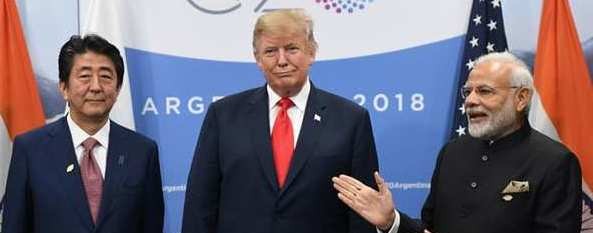
It would be fair to say that India is finally punching in accordance with its weight category, as far as defence diplomacy is concerned. For years, indeed decades, given its size both economically and militarily, New Delhi has been a relative underperformer in regional affairs, particularly when it comes to its eastern neighbours. It has somewhat limited its scope to South Asia, which obviously is of immediate strategic interest to her. Now for the first time, this country is willing to go the extra mile, when it comes to aligning herself with global powers, without the baggage of esoteric themes like Non-Alignment. Less than a month after a Quadrilateral meeting at the senior officials level, Prime Minister Narendra Modi, US President Donald Trump and Japan Prime Minister Shinzo Abe met in a trilateral format on the sidelines of the ongoing G-20 summit in Buenos Aires, Argentina, and agreed that a “free, open, inclusive and rules-based” order is essential for peace and prosperity in the Indo-Pacific. In a region where the footprints of the big dragon, the Peoples’ Republic of China, is increasingly making its presence felt, India is, perhaps, the only country in the region that can be reasonably relied upon to act as a counterweight to a nation, traditionally viewed as an aggrandizing power.
The best example of this came in the 73-day Doklam plateau standoff in 2017, where Beijing despite issuing many open and vile threats, was unable to push India beyond a point. The way in which China handles its many South East Asian neighbours, much tinier in size while protecting its strategic interests, is undiplomatic, to say the least. But clearly, to contain an economic and military behemoth like China is no easy job. Therefore the getting together of the three — Japan, America and India, aptly christened JAI — is a pointer to demonstrate that such tactical alliances are a must in a world where power flows from the barrel of the gun. Following from the old Kautilya dictum that an enemy’s enemy is a friend, the Modi government has concentrated upon improving its relations with Japan in the last four years. When three big powers get together and call for making the Indo-Pacific a region for shared economic growth and common prosperity, it does not need a rocket scientist to suggest whom the trilateral is aimed at. Both Trump and Abe lavished praise on India, suggesting that the world views New Delhi as an effective stabilizer against the disturbing might of Communist China. The trilateral meeting comes at a time when China is engaged in territorial disputes in the Indo-Pacific, most importantly with Japan and a host of other neighbours, who have been suitably cowed down by the dragon’s unfriendly noises. But very clearly, Modi is not putting all his eggs in one diplomatic basket. Hours earlier, he had held a meeting, again on the G-20 sidelines with Chinese President Xi Jinping and Russian President Vladimir Putin. This time, the three countries called for reforming global multilateral institutions. If anything, this constitutes a classic case of genuine non-alignment.


.jpeg)

